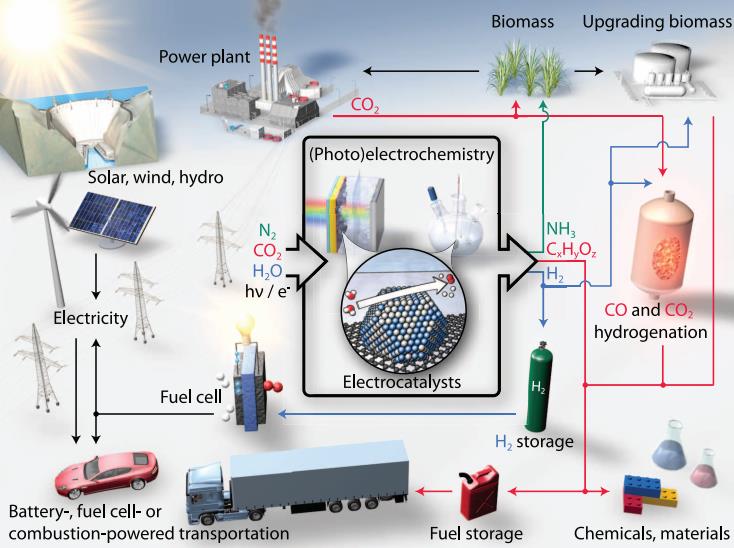electrocatalysis
QQ Academic Group: 1092348845
Detailed
Combining theory and experiment in electrocatalysis: Insights into materials design
BACKGROUND
With a rising global population, increasing energy demands, and impending climate change, major concerns have been raised over the security of our energy future. Developing sustainable, fossil-free pathways to produce fuels and chemicals of global importance could play a major role in reducing carbon dioxide emissions while providing the feedstocks needed to make the products we use on a daily basis. One prospective goal is to develop electrochemical conversion processes that can convert molecules in the atmosphere (e.g., water, carbon dioxide, and nitrogen) into higher-value products (e.g., hydrogen, hydrocarbons, oxygenates, and ammonia) by coupling to renewable energy. Electrocatalysts play a key role in these energy conversion technologies because they increase the rate, efficiency, and selectivity of the chemical transformations involved. Today’s electrocatalysts, however, are inadequate. The grand challenge is to develop advanced electrocatalysts with the enhanced performance needed to enable widespread penetration of clean energy technologies.
ADVANCES
Over the past decade, substantial progress has been made in understanding several key electrochemical transformations, particularly those that involve water, hydrogen, and oxygen. The combination of theoretical and experimental studies working in concert has proven to be a successful strategy in this respect, yielding a framework to understand catalytic trends that can ultimately provide rational guidance toward the development of improved catalysts. Catalyst design strategies that aim to increase the number of active sites and/or increase the intrinsic activity of each active site have been successfully developed. The field of hydrogen evolution, for example, has seen important breakthroughs over the years in the development of highly active non–precious metal catalysts in acid. Notable advancements have also been made in the design of oxygen reduction and evolution catalysts, although there remains substantial room for improvement. The combination of theory and experiment elucidates the remaining challenges in developing further improved catalysts, often involving scaling relations among reactive intermediates. This understanding serves as an initial platform to design strategies to circumvent technical obstacles, opening up opportunities and approaches to develop higher-performance electrocatalysts for a wide range of reactions.
OUTLOOK
A systematic framework of combining theory and experiment in electrocatalysis helps to uncover broader governing principles that can be used to understand a wide variety of electrochemical transformations. These principles can be applied to other emerging and promising clean energy reactions, including hydrogen peroxide production, carbon dioxide reduction, and nitrogen reduction, among others. Although current paradigms for catalyst development have been helpful to date, a number of challenges need to be successfully addressed in order to achieve major breakthroughs. One important frontier, for example, is the development of both experimental and computational methods that can rapidly elucidate reaction mechanisms on broad classes of materials and in a wide range of operating conditions (e.g., pH, solvent, electrolyte). Such efforts would build on current frameworks for understanding catalysis to provide the deeper insights needed to fine-tune catalyst properties in an optimal manner. The long-term goal is to continue improving the activity and selectivity of these catalysts in order to realize the prospects of using renewable energy to provide the fuels and chemicals that we need for a sustainable energy future.
Electrochemical energy conversion.Schematic showing electrochemical conversion of water, carbon dioxide, and nitrogen into value-added products (e.g., hydrogen, hydrocarbons, oxygenates, and ammonia), using energy from renewable sources. The combination of theoretical and experimental studies working in concert provides us with insight into these electrochemical transformations and guides the development of the high-performance electrocatalysts needed to enable these technologies.
来源Source:
http://www.cailiaoniu.com
http://www.nanoer.net
- Previous: Microfluidic device
- Next: 1


 About us
About us

